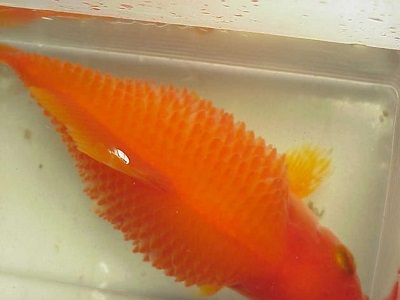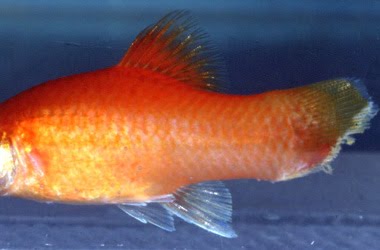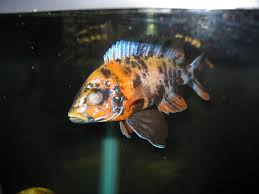All Articles, Fish Diseases
Fish Diseases – Bacterial
When fish are ill do not feed them! Sick fish will not eat and this uneaten food can cause further harm if not scooped out of the pond.
FIN ROT
Fin rot is a common bacterial infection in fish. It generally occurs on fish that already have poor health. Transportation, rough handling, fighting, overcrowding and poor water conditions can contribute to the occurrence of Fin Rot. If Fin Rot is noticed in the early stages and treated then there is a chance that they will survive. If left untreated then it can infect other fish in the pond and they will all eventually die.
- Ragged or Split Fins.
- Fins white around the edges.
- Infected area may become inflamed.
TREATMENT:
- Test the water - if one of the reasons for the poor health of the fish is from overcrowding or poor water quality you will want to make sure that there is no Ammonia or Nitrite present in the pond.
- Do a water change - If you are using Tap Water make sure to use a Water Conditioner (Stress Coat is perfect as it has added benefits to help build up the fish protective slime coating). Adding in Clarifier Bacteria will help break down any toxins, such as Ammonia or Nitrite that may be present. If you are having a problem with high phosphorus, ammonia or nitrogen levels I would recommend Zeolite. Zeolite is a natural product that effectively absorbs excess nutrients, ammonia and nitrites from the pond water, improving fish health and reducing algae problems.
- Use a Bacterial Remedy to help control the Fin Rot. PondCare Melafix or PondMax MediMax are both great treatments that can be used for this. You can also add in Pond Salt which will help to build-up lost electrolytes.
DROPSY (PINECONE DISEASE)
Dropsy is a common disease in fresh water fish. It is easily recognisable by protruding scales and a swollen body, giving the fish a ‘pinecone’ appearance. This is caused by a bacteria (Aeromonas) that is harmful to fish when they are stressed due to electrolyte imbalance, poor nutrition, overcrowding or poor water quality. This is generally not contagious but the fish may be isolated if you feel necessary. It will not harm other fish if you were to treat the pond the fish is already in. If anything it will give the other fish a boost. If treated in early stages the fish may survive.
SYMPTOMS:
- Swollen Body.
- Protruding Scales.
- Pale Gills.
- Floats near surface of pond.
TREATMENT:
- Test the water - if one of the reasons for the poor health of the fish is from overcrowding or poor water quality you will want to make sure that there is no Ammonia or Nitrite present in the pond.
- Do a water change - If you are using Tap Water make sure to use a Water Conditioner (Stress Coat is perfect as it has added benefits to help build up the fish protective slime coating). Adding in Clarifier Bacteria will help break down any toxins, such as Ammonia or Nitrite that may be present. If you are having a problem with high phosphorus, ammonia or nitrogen levels I would recommend Zeolite. Zeolite is a natural product that effectively absorbs excess nutrients, ammonia and nitrites from the pond water, improving fish health and reducing algae problems.
- Treat with PondCare PimaFix or PondMax MediMax are both great treatments that can be used for this. You can also add in Pond Salt.
EYE CLOUD
Eye Cloud is noticeable by a whitish haze that can infect one or two fish in a pond but isn’t considered to be infectious. It is generally caused by extremely low pH levels, poor water quality and poor nutrition.
- Whitish Haze in eyes.
TREATMENTS:
- Test the water - You should do an entire water test and not just focus on the pH. If your pH is extremely low then the fish may be exhibiting other symptoms and may be quite lethargic.
- Do a water change - If you are using Tap Water make sure to use a Water Conditioner (Stress Coat is perfect as it has added benefits to help build up the fish protective slime coating). Adding in Clarifier Bacteria will help break down any toxins, such as Ammonia or Nitrite that may be present. If you are having a problem with high phosphorus, ammonia or nitrogen levels I would recommend Zeolite. Zeolite is a natural product that effectively absorbs excess nutrients, ammonia and nitrites from the pond water, improving fish health and reducing algae problems.
- Treat with PondCare PimaFix/MelaFix or PondMax MediMax are both great treatments that can be used for this. You can also add in Pond Salt.
SALT is a great all-round treatment for fish. Even if you are unsure of what is wrong with your fish you can always add salt as it helps with a wide range of problems. The Dosage of Salt is 1kg to every 1000 litres of water but Salt should not be re-applied as it doesn’t evaporate or filter out of the water. The only way to get rid of it is to do a water change and even then you may still have salt present.
SALT:
- Reduces Fish Stress.
- Adds Electrolytes.
- Improves Gill Function.
- Prevents Nitrite poisoning.
- Help improve recovery from disease.
- Kills parasites.


